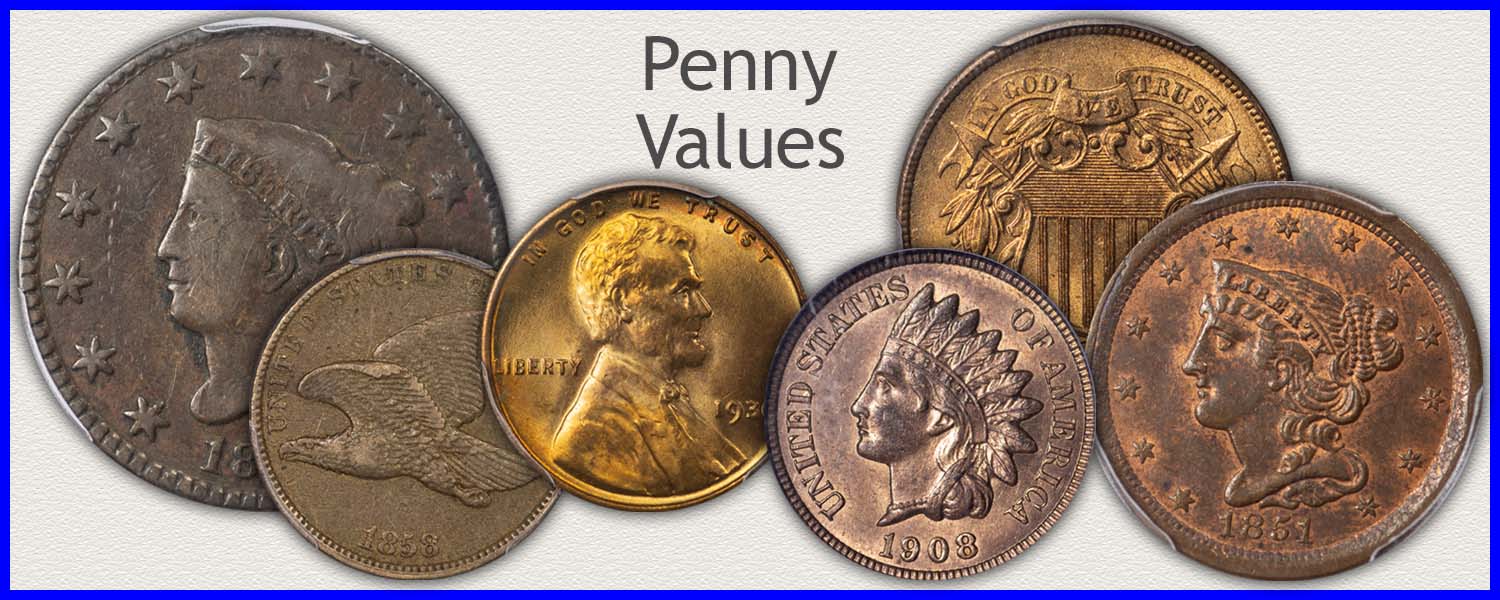Coin Values Moving with Precious Metals: Up-Dated 12/15/2025: Gold $4341 | Silver $63.26
American Large Cent Values
The American large cent was a heavily used denomination at the beginning of U.S. coinage. Most stayed in commerce until they became almost unrecognizable. Today, all dates and conditions are popular as a collectible. Importantly, a heavily worn large cent in "Good" condition supports a strong minimum value.
Collectors pursuing these old and scarce coins underpin American large cent values. The following chart shows a wide range in how much these are worth. Identifying where your coin fits on the chart is a defined step by step process.
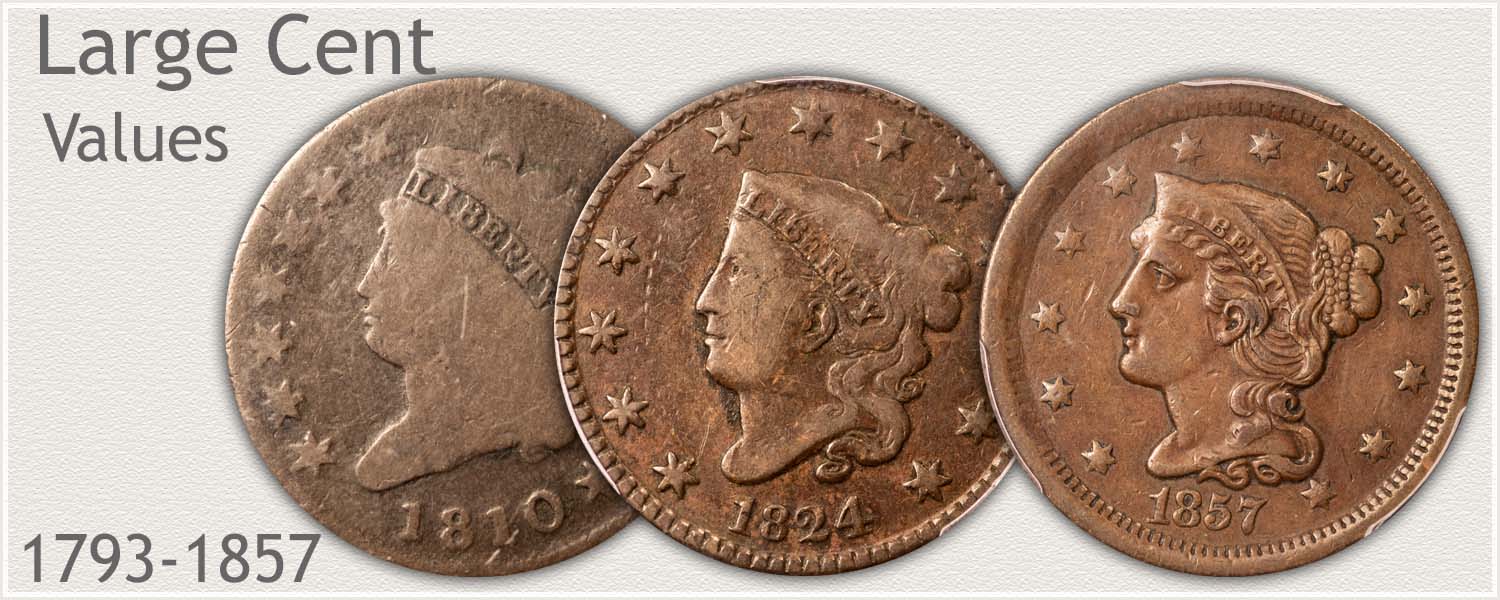
Steps Leading to Value:
- Step 1: Date and Variety - Accurately identify different dates and different varieties over the long running large cent series.
- Step 2: Grading Condition - Important elements are judged and condition is graded.
- Step 3: Special Qualities - Subtle factors moving value up or down are identified to these unique pure copper coins.
A typical large cent collection is assembled by dates, with each date recognized by levels of rarity. Accuracy of date and variety is important. State of preservation is next judged. Ample details of design remaining add to the appeal. Comparing your coin to images is used to recognize details, condition, and grade. The coin's surface is further examined to find enhancing qualities.
| American Large Cent Values | ||||
|---|---|---|---|---|
| Condition of Coin | ||||
| Date | Good | Fine | Extremely Fine | Mint State |
| Large Cent Values Updated | 2025 | |||
| 1793 Chain | $6,013 | $24,400 | RARE | RARE |
| 1793 Wreath | $2,700 | $4,798 | $17,850 | RARE |
| 1793 Liberty | RARE | RARE | RARE | RARE |
| 1794 | $380 | $1,169 | $5,070 | $16,350 |
| 1795 | $309 | $844 | $2,745 | RARE |
| 1796 | $496 | $1,260 | $5,794 | RARE |
| Draped Bust Variety 1796-1807 | ||||
| 1796 | $397 | $2,863 | $5,123 | RARE |
| 1797 | $174 | $460 | $2,660 | RARE |
| 1798 | $147 | $347 | $1,655 | RARE |
| 1799 | $4,110 | $10,863 | RARE | RARE |
| 1800 | $75 | $280 | $2,208 | RARE |
| 1801 | $68 | $236 | $1,285 | RARE |
| 1802 | $81 | $241 | $1,094 | RARE |
| 1803 | $72 | $209 | $1,188 | $4,500 |
| 1804 | $2,323 | $5,160 | RARE | RARE |
| 1805 | $89 | $255 | $855 | $4,915 |
| 1806 | $82 | $324 | $1,015 | RARE |
| 1807 | $120 | $330 | $1,438 | RARE |
| Classic Head Variety 1808-1814 | ||||
| 1808 | $89 | $512 | RARE | RARE |
| 1809 | $142 | $738 | RARE | RARE |
| 1810 | $110 | $404 | $1,661 | RARE |
| 1811 | $212 | $420 | $2,269 | RARE |
| 1812 | $99 | $352 | $1,491 | RARE |
| 1813 | $104 | $435 | $1,406 | RARE |
| 1814 | $103 | $420 | $1,331 | RARE |
| Coronet Variety 1816-1839 | ||||
| 1816 | $43 | $84 | $408 | $661 |
| 1817 | $40 | $64 | $310 | $615 |
| 1818 | $28 | $51 | $191 | $506 |
| 1819 | $26 | $40 | $204 | $1,000 |
| 1820 | $23 | $49 | $194 | $401 |
| 1821 | $46 | $198 | $1,031 | RARE |
| 1822 | $26 | $60 | $365 | $1,003 |
| 1823 | $100 | $294 | $4,475 | RARE |
| 1824 | $33 | $89 | $498 | $2,700 |
| 1825 | $27 | $79 | $387 | RARE |
| 1826 | $29 | $57 | $222 | $1,160 |
| 1827 | $31 | $58 | $230 | $1,289 |
| 1828 | $25 | $49 | $270 | $930 |
| 1829 | $38 | $72 | $171 | $2,695 |
| 1830 | $25 | $56 | $200 | $804 |
| 1831 | $24 | $41 | $114 | $611 |
| 1832 | $20 | $59 | $162 | $637 |
| 1833 | $22 | $38 | $148 | $652 |
| 1834 | $21 | $46 | $203 | $693 |
| 1835 | $19 | $41 | $147 | $691 |
| 1836 | $22 | $43 | $171 | $415 |
| 1837 | $19 | $45 | $154 | $408 |
| 1838 | $22 | $42 | $129 | $337 |
| 1839 | $23 | $34 | $166 | $690 |
| Braided Hair Variety 1839-1857 | ||||
| 1839 | $23 | $39 | $121 | $382 |
| 1840 | $23 | $40 | $93 | $578 |
| 1841 | $24 | $38 | $103 | $433 |
| 1842 | $23 | $37 | $84 | $426 |
| 1843 | $26 | $35 | $113 | $425 |
| 1844 | $19 | $26 | $83 | $425 |
| 1845 | $23 | $25 | $81 | $234 |
| 1846 | $22 | $28 | $86 | $349 |
| 1847 | $22 | $27 | $83 | $298 |
| 1848 | $22 | $29 | $84 | $271 |
| 1849 | $19 | $27 | $64 | $260 |
| 1850 | $22 | $25 | $46 | $212 |
| 1851 | $15 | $23 | $53 | $180 |
| 1852 | $23 | $26 | $52 | $190 |
| 1853 | $23 | $28 | $58 | $214 |
| 1854 | $18 | $22 | $62 | $176 |
| 1855 | $23 | $28 | $62 | $190 |
| 1856 | $23 | $25 | $52 | $208 |
| 1857 | $42 | $88 | $167 | $363 |
The above are wholesale coin values. Computed from dealer's price lists with various mark-up factors figured in. They reflect closely the value you would expect to receive when selling. Variations in value do occur subject to subtle grading points, collector demands and dealer needs.
Step 1: | Identify Date and Major Variety
Flowing Hair Variety 1793 to 1796
Scarce to rare in availability is helping drive values of these US cents. Add in the historical importance of the beginning of US coinage and their appeal is universal. Approximately 1.5 million 1793 to 1796 large cents were minted.
Symbolism important to America is portrayed on these first issues of the mint. Liberty with flowing hair faces right, a Liberty pole with cap is behind. Two major reverse varieties are found on issues of 1793; first a chain encircling One Cent and later a wreath was used. 1794 to 1796 continued with the olive wreath reverse.
Draped Bust Variety 1796 to 1807
1796 saw a redesign of Liberty on the obverse and no longer is the Liberty pole and cap part of the obverse design. Reverse is similar as earlier years with an olive wreath surrounding One Cent
Majority of Draped Bust large cents known today are heavily worn. Any with detail remaining within Liberty's hair are above average condition. Dedicated collectors examine each coin closely and it is these collectors forming a solid base to values.
These Draped Bust cents are less scarce; however, popularity is a driving force to strong values.
Classic Head Variety 1808 to 1814
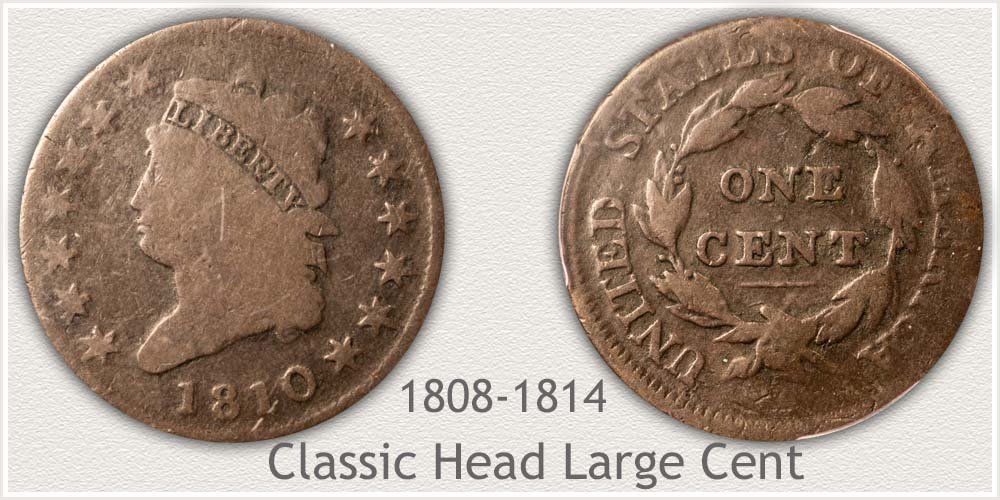
A short-lived design change in 1808 produced a finely detailed portrait of Liberty. Unfortunately, most coins available today are worn and lack most of the finer points of original design. Values for lightly worn Classic Head large cents are very strong, reflective of demand by collectors.
Just over 4.5 million of the variety were struck, placing these as one of the scarce varieties of Large cents.
Coronet Head Variety 1816 to 1839
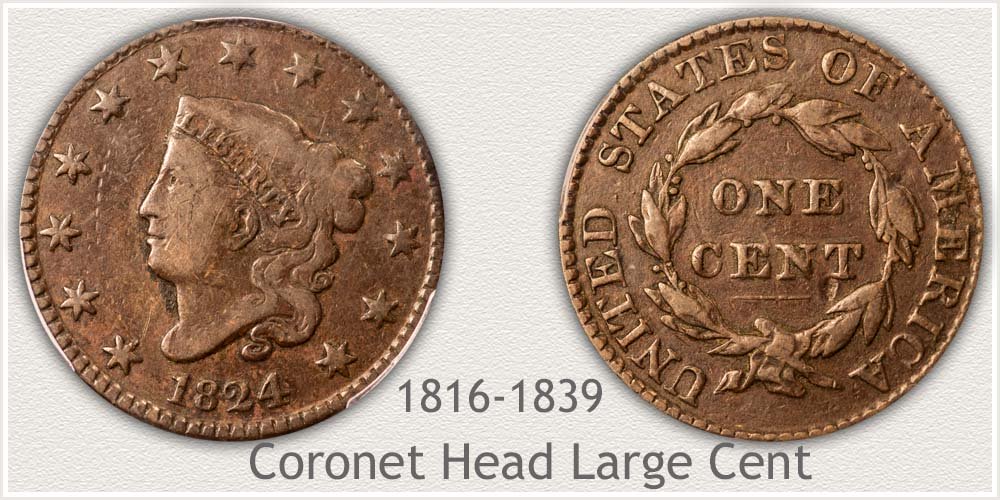
A redesign of Liberty now portrays her hair knotted at back of head. Facial features have changed as well. Reverse wreath remains very similar to earlier years.
Many collectors of large cents focus on the Coronet Head variety. A challenge faced is finding examples with pleasing surfaces. Heavy use in commerce resulted in wear, marks, and discoloration.
Braided Hair Variety 1839 to 1857
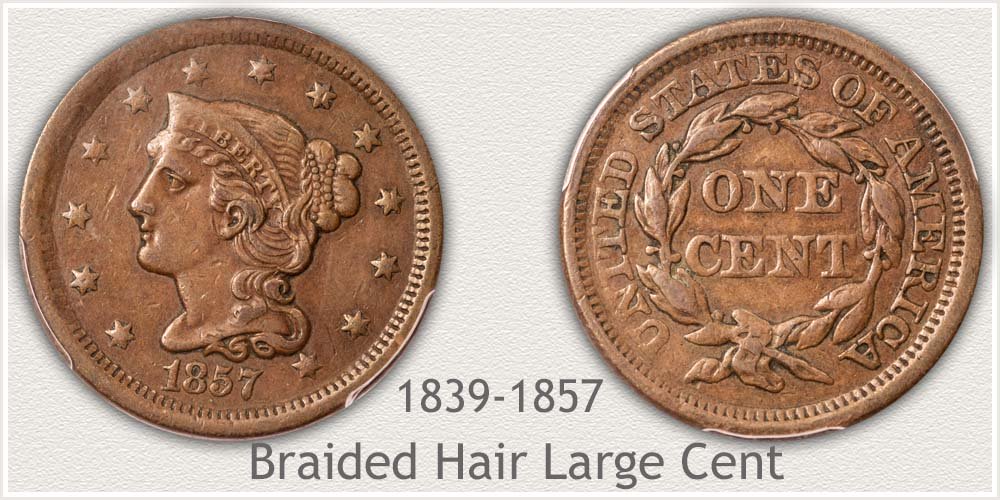
Final design of the Large cent series was restyled in 1839 with Liberty slightly smaller. Changes include a beaded cord tying the hair and a different style to band with "Liberty" inscribed. Very minor changes to the wreath on the reverse with a minor increase in size to One Cent.
A large sized coin, bold in relief and available in many value ranges lends to the popularity of the final variety of large cents. Grading condition is key to an accurate value.
Step 2: | Grade Determines American Large Cent Values
Grading condition narrows value range on chart. In order to determine how much your coin is worth it is necessary to "grade" its condition.
The concept is straight forward... as a coin circulates and wears, all the varying degrees of its condition are each assigned a grade.
Compare your coin to the grading images for each variety and find a close match. The more detail evident the better its condition and grade. If your coin is slightly nicer than pictured, use the higher value of the price range.
Amazingly, some examples of the American large cent survive today in uncirculated - mint state grade, meaning no signs of wear. Skill is required to accurately grade a mint state large cent. At a high level of condition, small differences in grade often have large differences in value.
Grading Condition of Coronet Head Large Cents
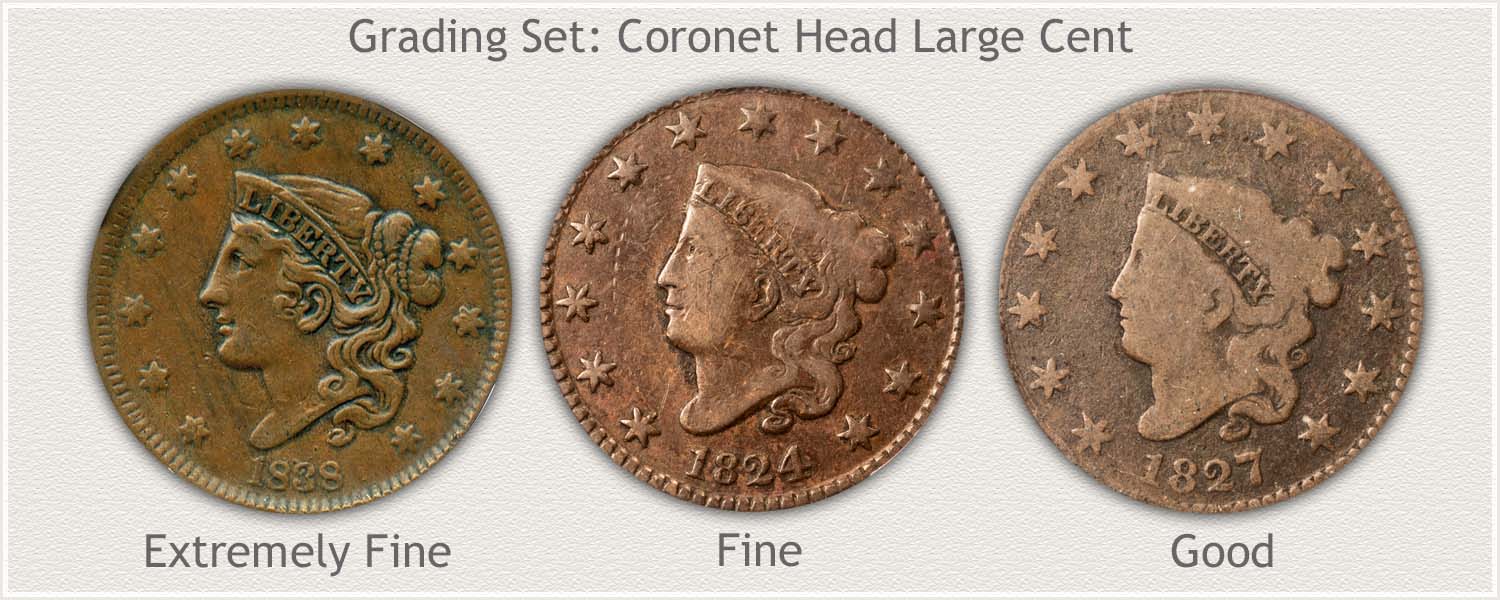
Extremely Fine Grade: Coronet Head Large Cent
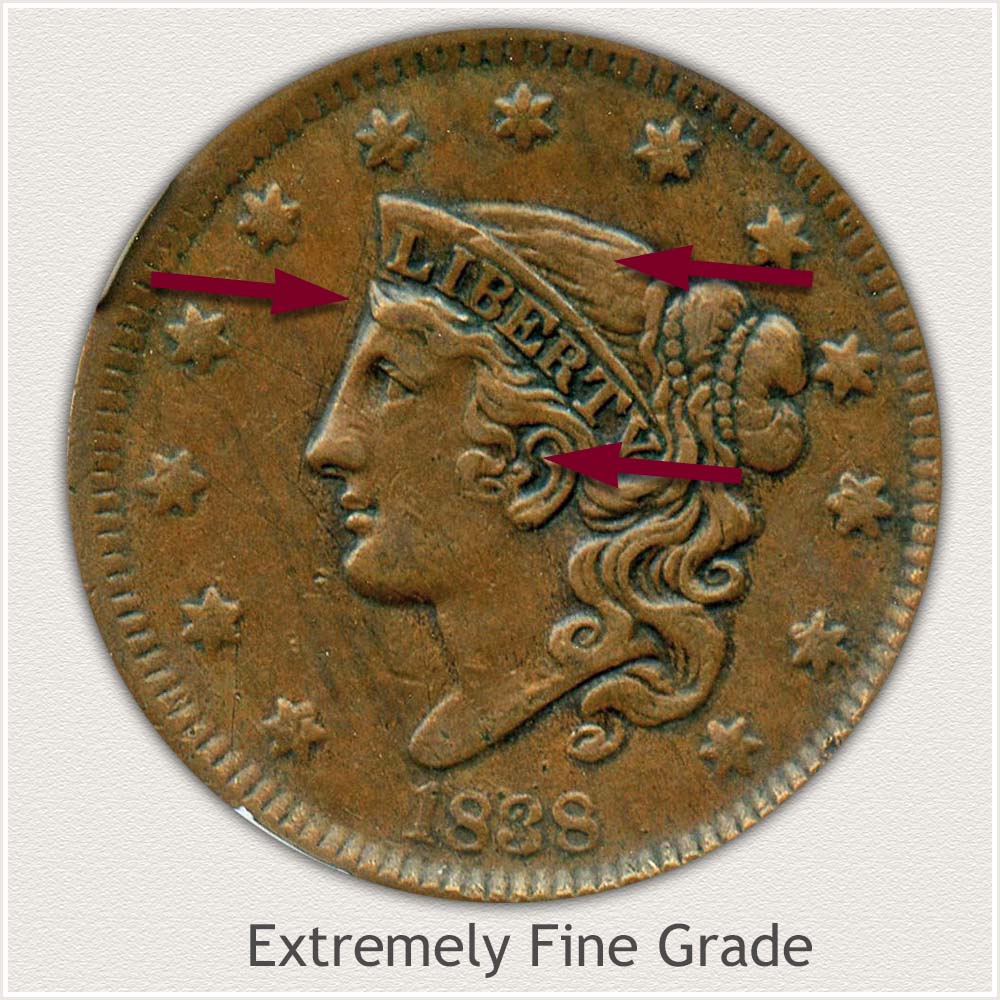
Obverse: A slight amount of wear now appears on the highest parts of the design. Slight wear defines the Extremely Fine grade.
Waves of hair just above Liberty's eye show a small area of flatness on the forward most strands. Much of the fine strands are missing.
In front of the ear, separation remains between waves and curl of hair. A clear but small flat area is found on the tops of each element but all are separated.
Above the coronet, hair strands are showing signs of flattening due to wear. Missing strands of hair is confined to a small area in front of the first cord tying the hair.
Liberty's ear remains well defined with much of the contours forming the ear well rounded. Only light wear is present.
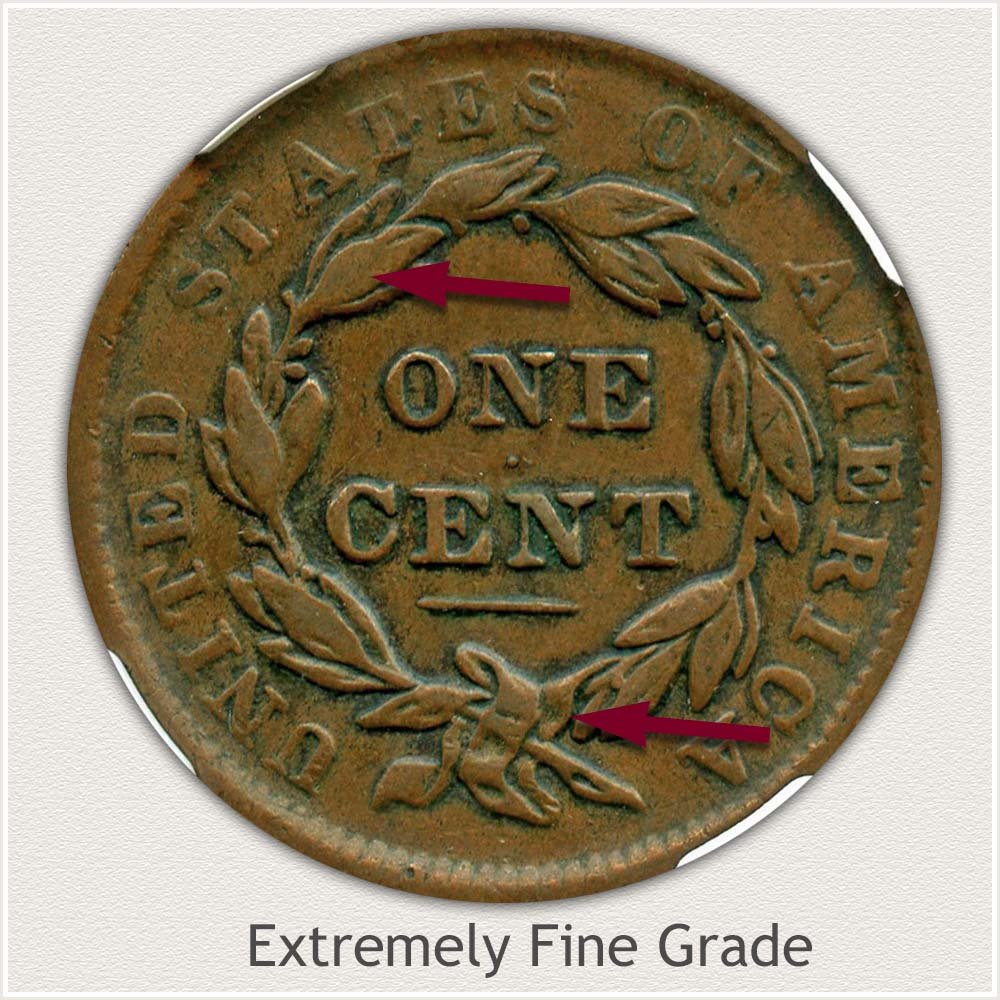
Reverse: Uppermost leaf of each grouping is now showing a small flat area. Inner detail of these top leaves is flattened. Although the uppermost leaf is somewhat smooth it remains separated and defined from lower leaves.
The ribbon holding the beginning stem and ending leaves of the laurel branch is often well struck. A touch of wear is smoothing the ribbon as it passes over the branch. Edges of the ribbon remain well defined.
Fine Grade: Coronet Head Large Cent
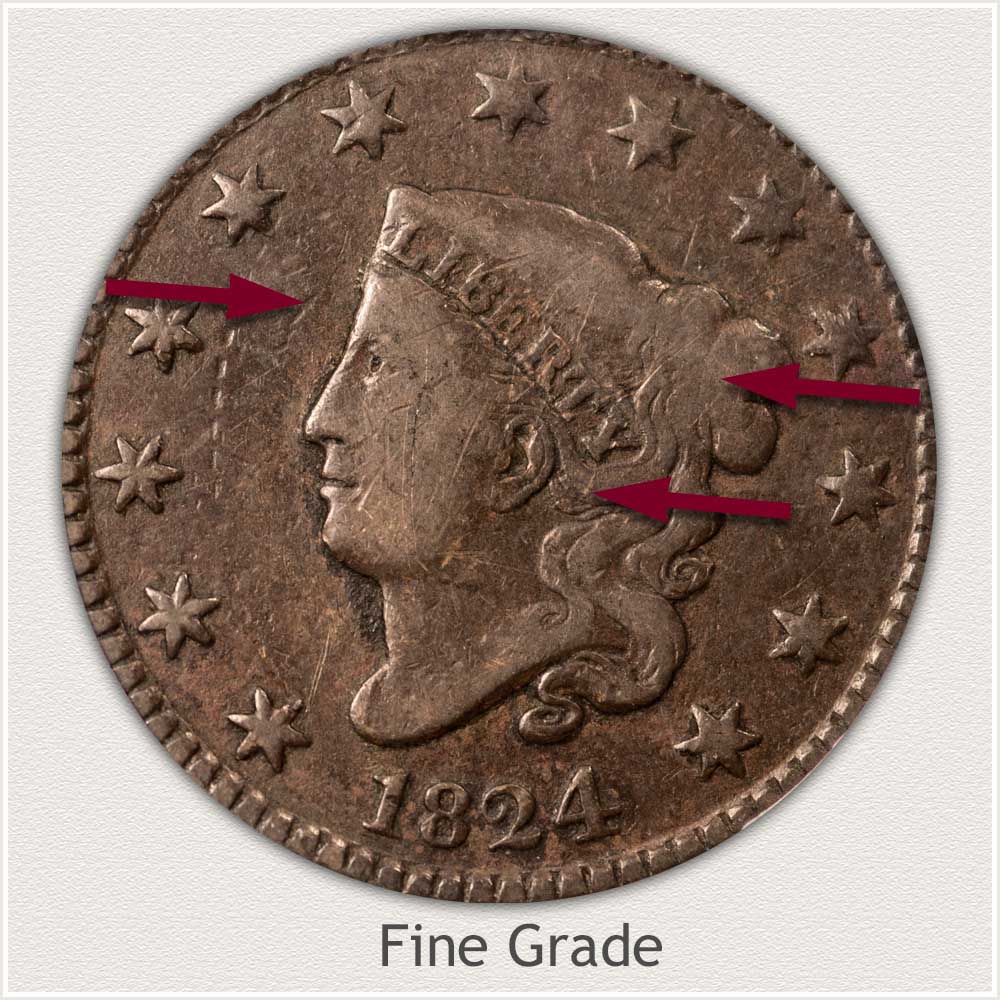
Obverse: Moderate to heavy wear defines a large cent's condition in Fine grade.
Heavy wear has removed all details to the highest points of the design. Liberty's face is now a flat area from above her eye to chin line.
Remaining hair strands still show around portions of ear. These strands are lower within the design and their presence helps define a Fine grade.
A small area of finer detail within the hair is evident above "T" in Liberty. Evidence of a cord tying the hair remains.
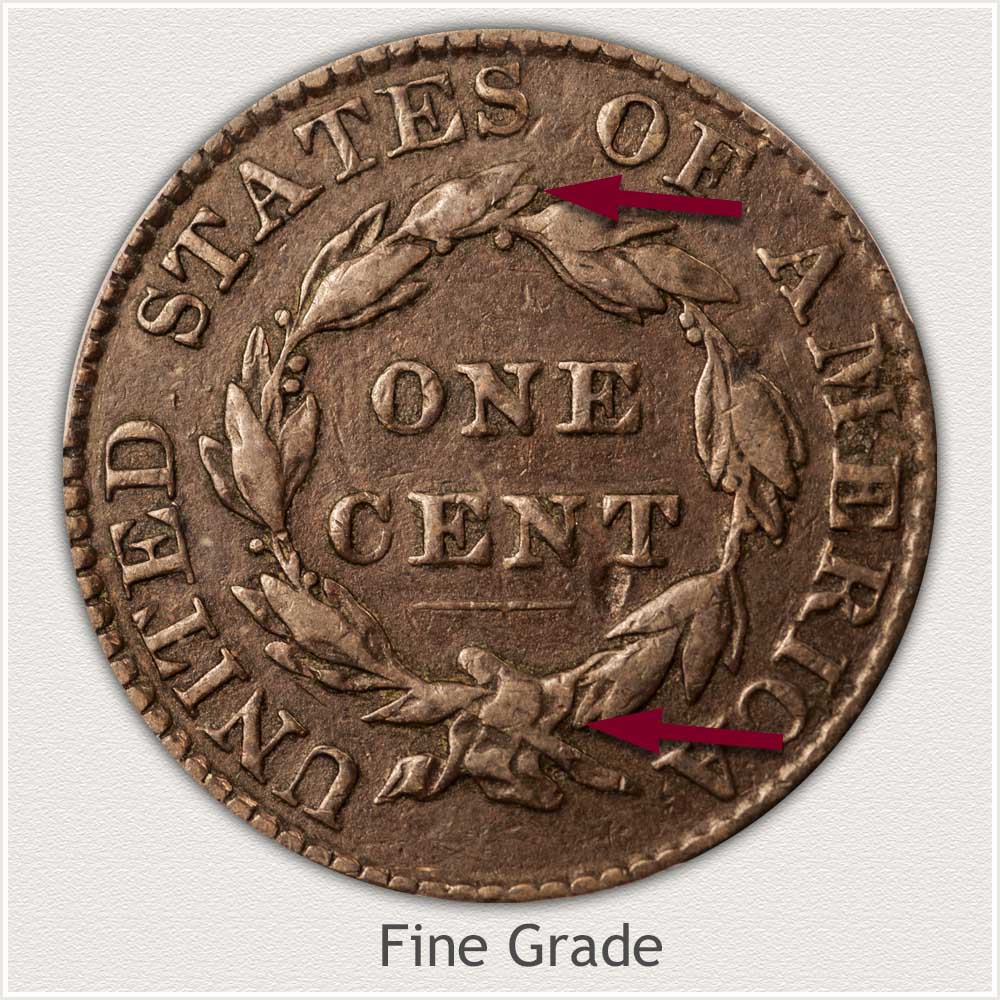
Reverse: Wear has now flattened the uppermost leaf of each grouping. Very little central detail - if any - remains.
Each leaf is still separated, helping place this coin in the Fine grade. Edges of leaves are well defined although faint in areas.
Ribbon is showing large areas of flatness. The area of the ribbon crossing over the stem portion of the laurel branch is lacking any high point and often blended at the edges. A mostly complete out-line of the full ribbon remains. The right most area of the ribbon still indicates it passes under the stem.
Good Grade: Coronet Head Large Cent
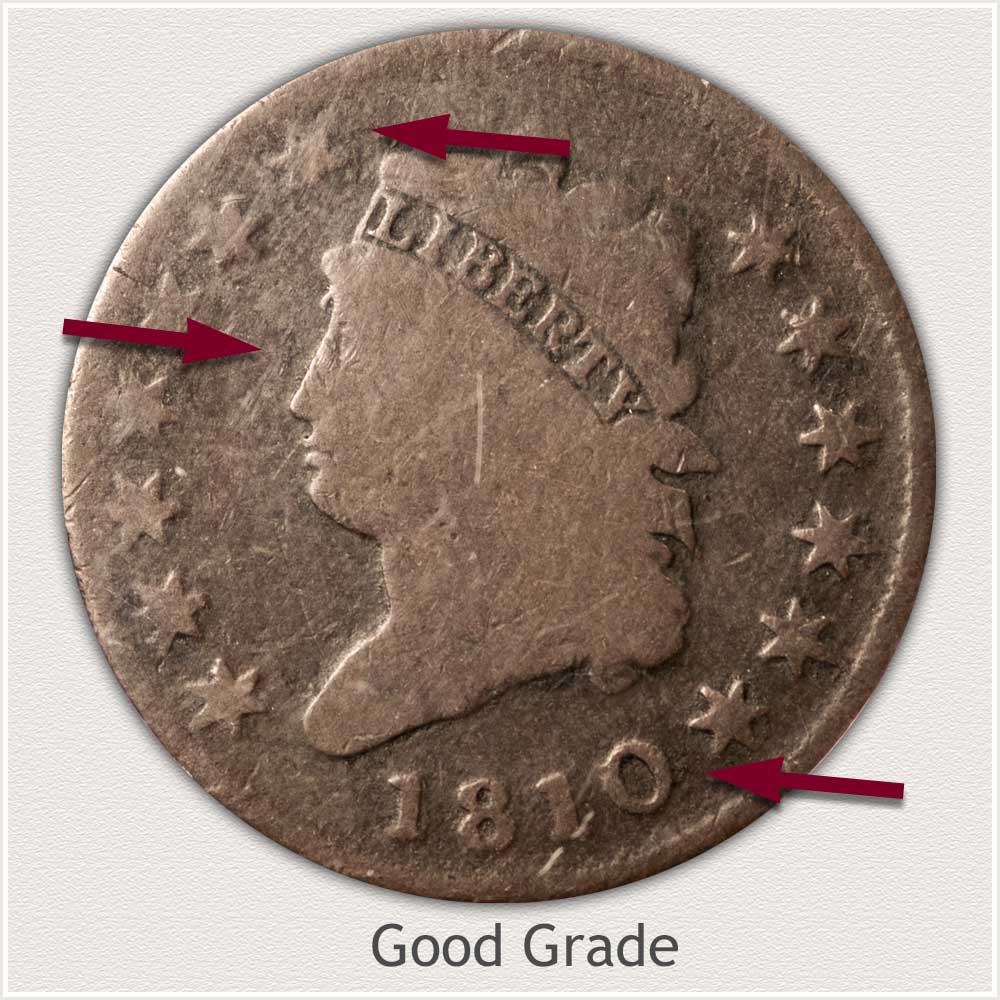
Obverse: Heavy wear flattening all minor and most major detail is the condition of a large cent in the Good grade.
Liberty's face in now a smooth flat surface. No contours indicating a cheek, eyebrow ridge and separation of chin from neck are visible.
Date remains complete, readable and raised from the field of the coin. A strong rim is a key feature defining the good grade.
Notice all stars are distinct, and raised. On occasion a weak star is present due to a weak strike area.
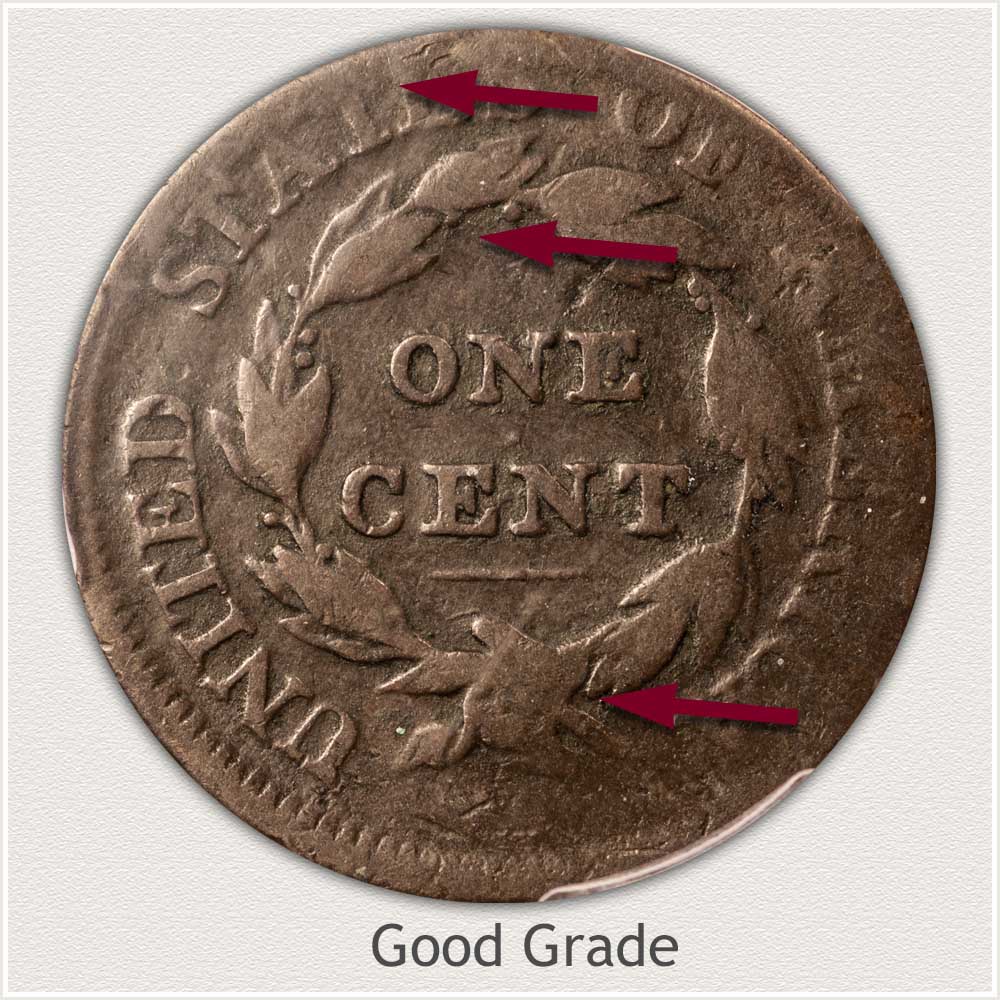
Reverse: Wear has removed all minor detail of upper most leaves of each group. A strong indication separating individual leaves remains. Lower leaves are defined.
Ribbon tying the stem at the bottom is now lacking most detail. Lines separating parts of the ribbon are gone resulting in a large flattened design.
Lettering is plain and readable. Tops of letters near the rim are weak but most remain separate from rim and field of coin. Occasionally a weak area of strike is causing a merging of legend with rim but limited to the tops of letters. A defined rim and lettering is preferred by collectors as it clearly separates the coin from a lower condition.
Grading Condition of Braided Hair Large Cents 1839 to 1857
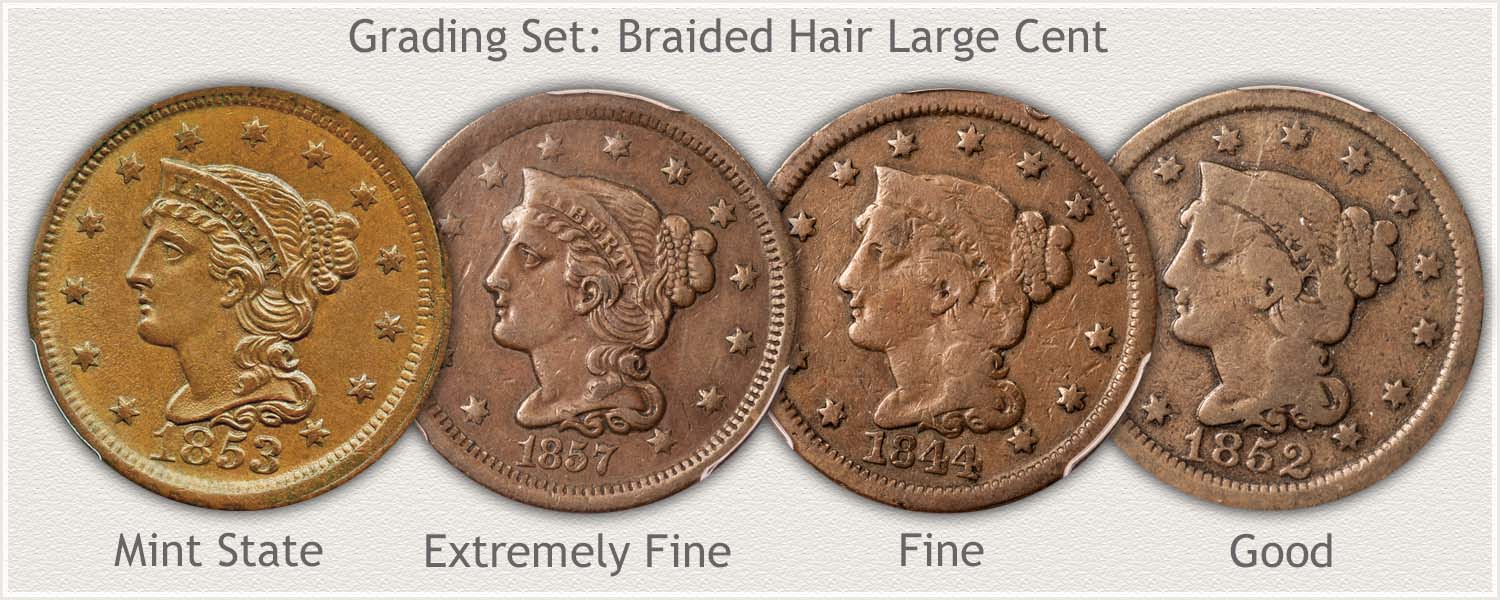
Mint State Grade: Braided Hair Large Cent
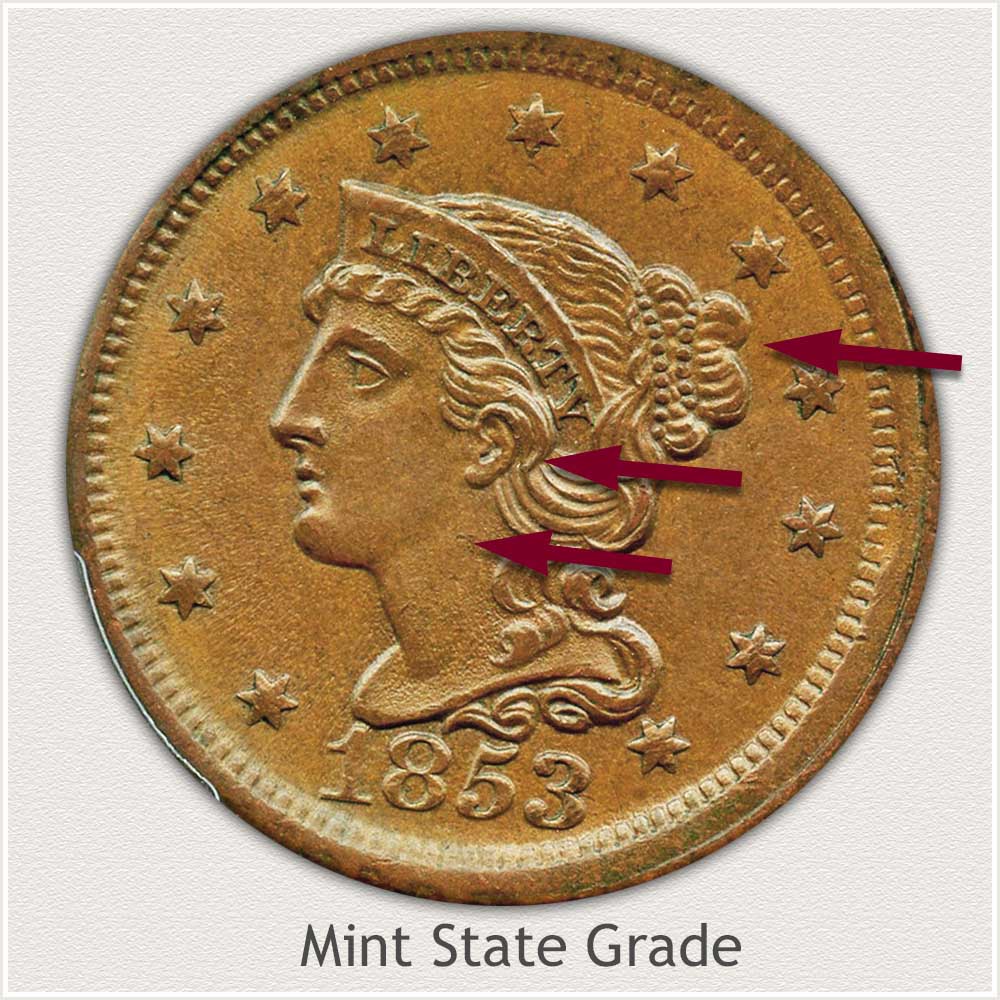
Obverse: A truly scarce coin and highly valued are Large cents in uncirculated - mint state condition. To reach this grade a deciding factor is no wear to the surface. All surfaces of a coin are inspected with highest areas of design a focal point.
A braided feature to Liberty's hair is now a design element. Each braid has a high area, subject to first signs of wear. Judge these high points of hair for any smoothing of texture to the metal, this indicates a slight amount of wear.
Liberty's ear is centrally located on the coin and just above are waves of hair, first to show a flattening or smoothing due to wear.
An open area high in relief is the cheek and neck areas of Liberty. A close look at the texture of the metal and noting it's the same as protected areas helps confirm a mint state surface.
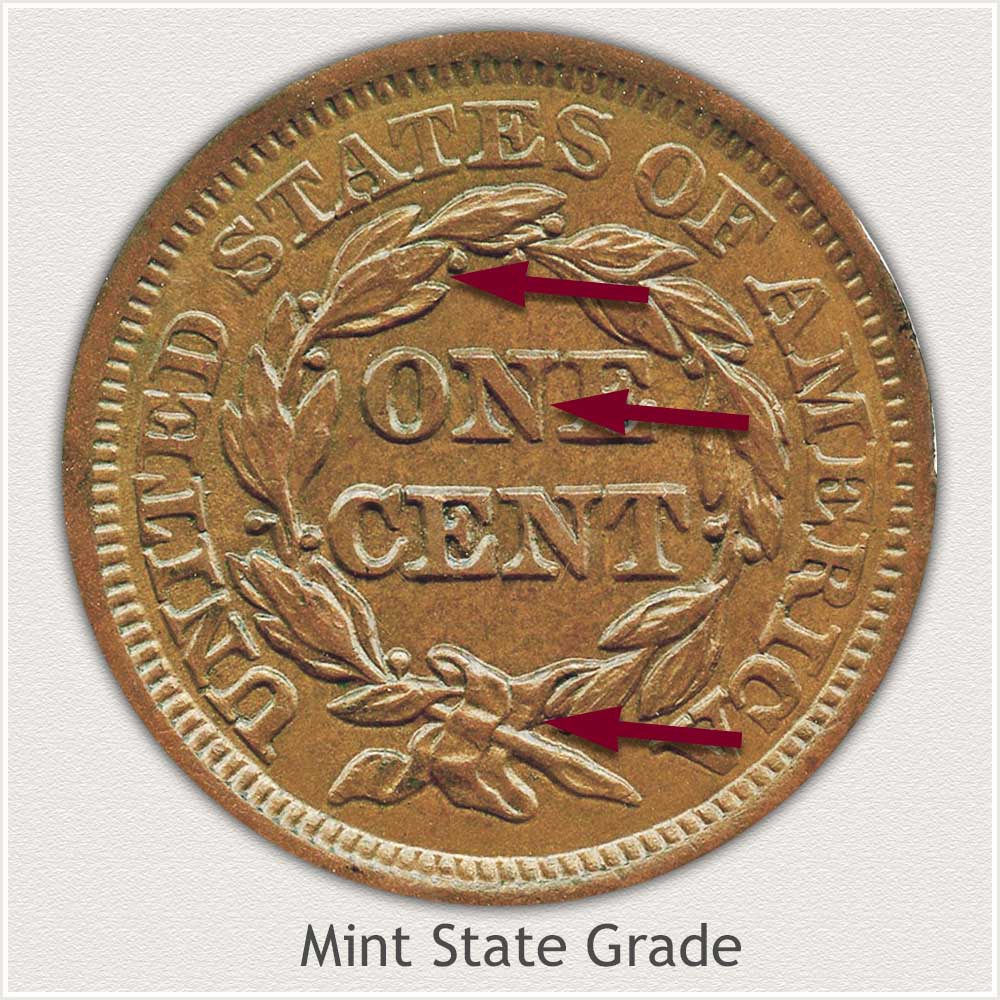
Reverse: A very bold laurel stem encircles One Cent as a design to the reverse. Each group of leaves has an upper most leaf subject to initial wear.
Within each upper leaf is a high point running through. High areas of all upper leaves are inspected for a texture change or smoothing of metal.
A ribbon is the design holding the stem at the bottom of the wreath. High parts of the ribbon draping over the stem receive any initial wear. Edges of the ribbon are also carefully inspected. Any flattening indicates wear.
Surfaces of both One Cent and the legend are judged. Any wear to the tops of the letters shows as smoothing.
Extremely Fine Grade: Braided Hair Large Cent
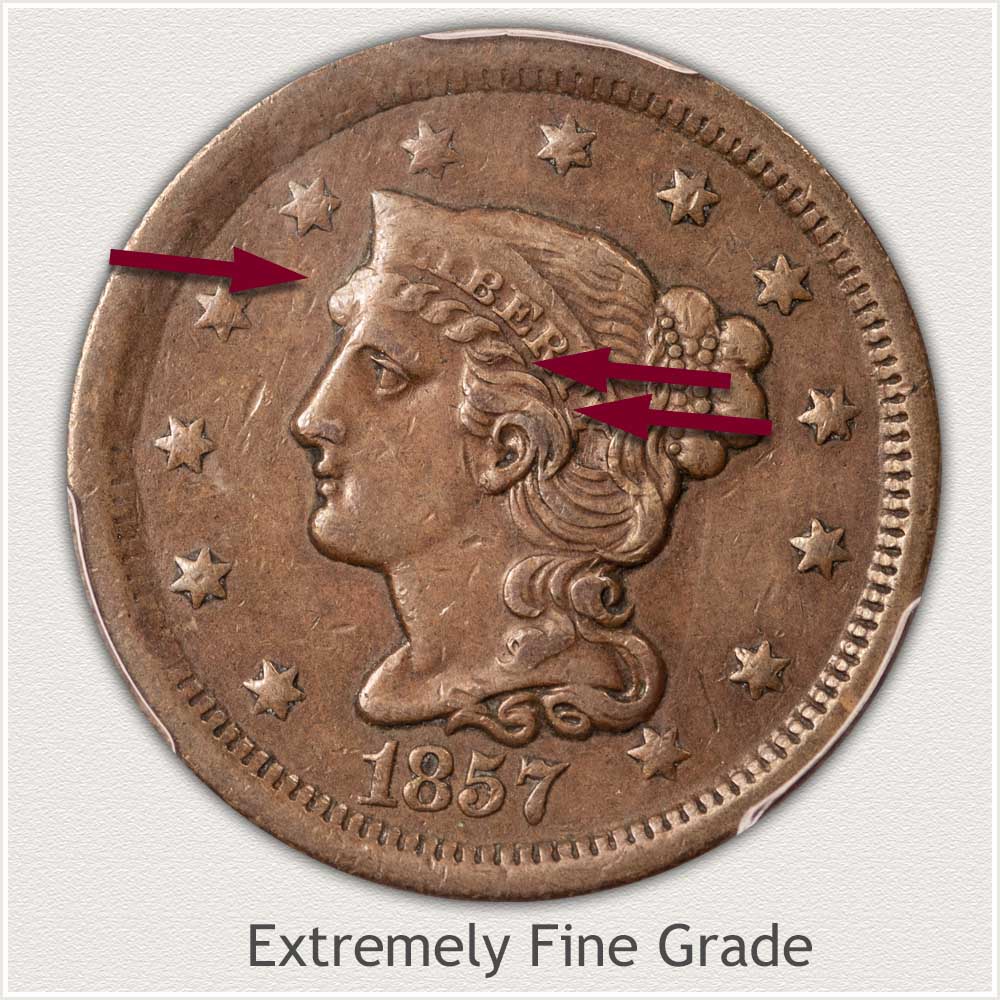
Obverse: A slight amount of wear merging small areas of fine detail defines the condition of a large cent in Extremely Fine grade.
Although wear is evident, it is confined to very small areas of high points. The braids of hair above Liberty's forehead show touches of wear flattening only small portions of the braids.
Just above the ear, waves of hair are smooth in a small area. Individual strands of hair are visibly worn and about to merge. Any definition of separate strands surrounding the ear adds appeal and value to these large cents.
Confirm strands of hair are separated in the waves in front of Liberty's ear.
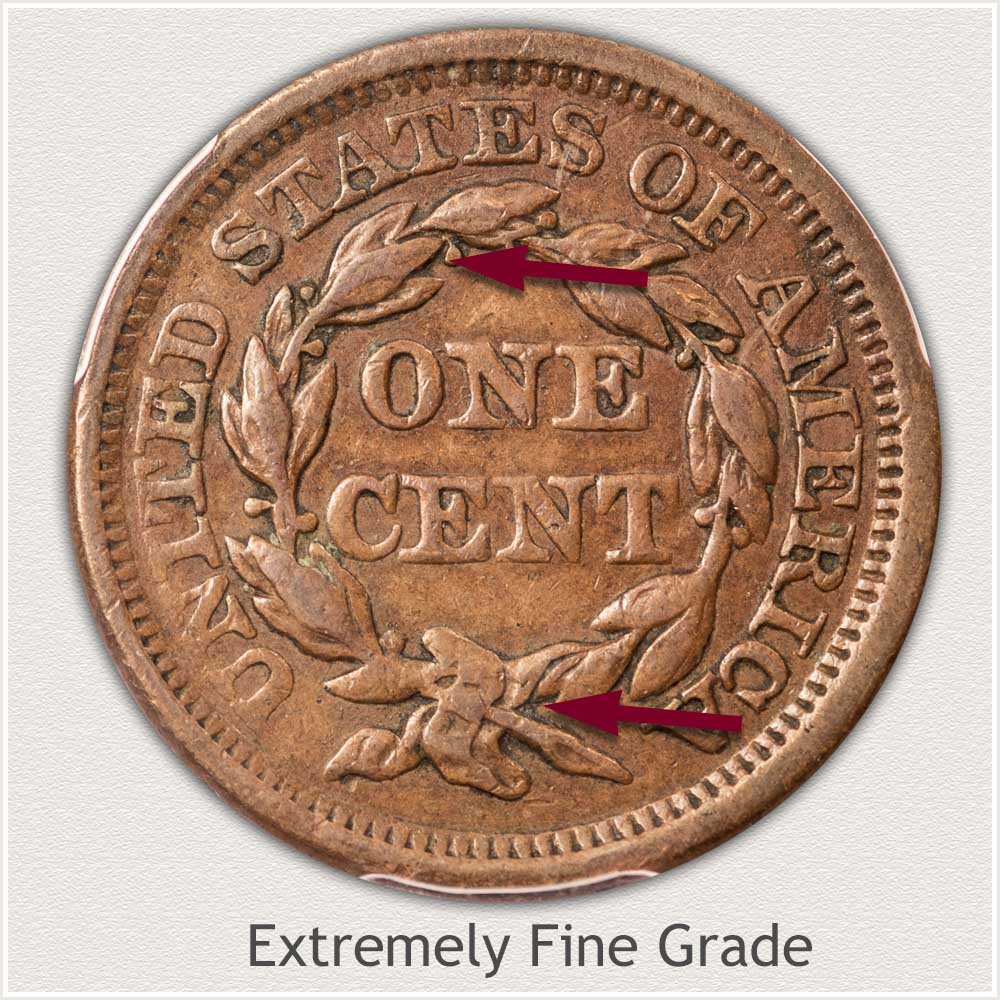
Reverse: Clearly defined elements of the laurel stem are needed to achieve a grade of Extremely Fine.
Upper most leaves are showing areas of flatness. Small central details of top leaves are missing. Lower leaves of each grouping are well-defined, edges are slightly worn but distinct.
The ribbon at the bottom of the wreath remains crisp. Edges of ribbon display a trace of wear and smoothing. A high relief area of the ribbon passing over the stem is just beginning to show flatness, remaining well detailed. All folds and waves of the ribbon are clear.
Fine Grade: Braided Hair Large Cent
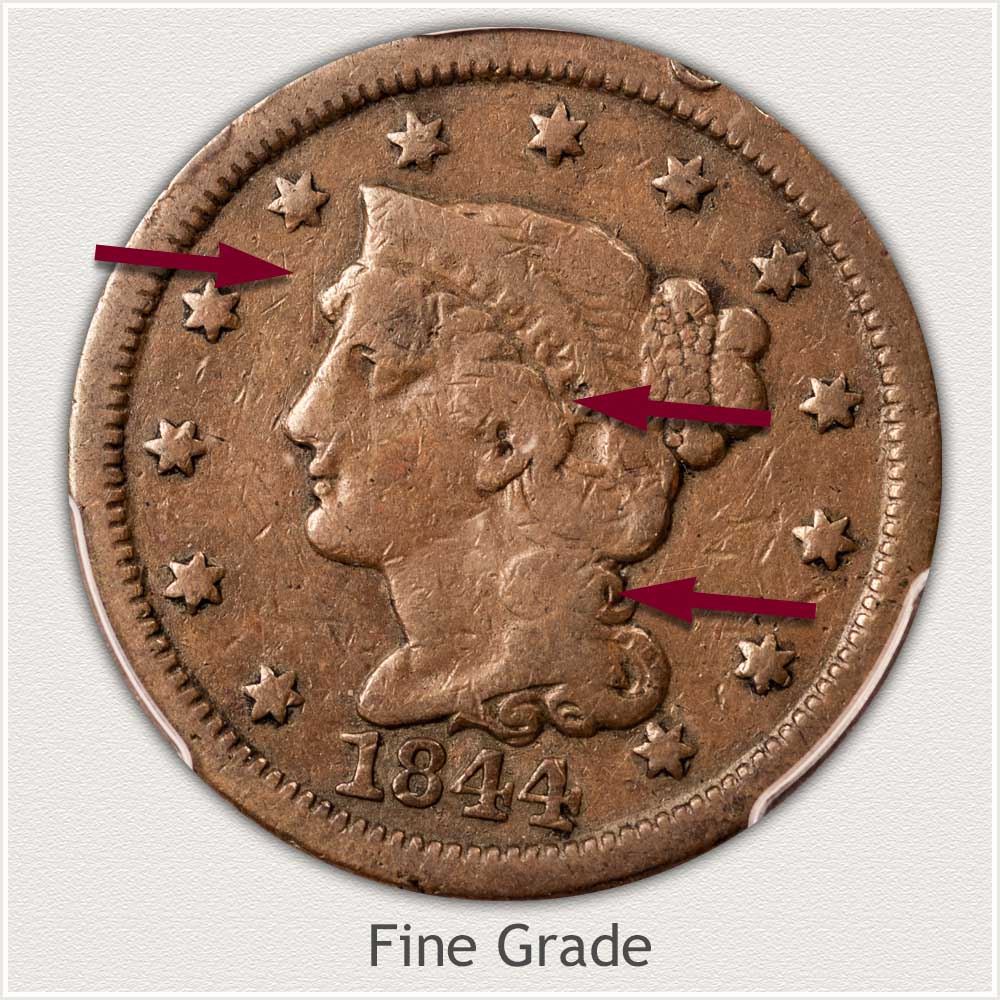
Obverse: Overall appearance of a large cent in Fine grade is a presence of flat areas within Liberty's hair and facial features.
Notable is any flatness observed is disconnected and confined to the separate design elements.
Hair above and surrounding the ear is merged with the ear and a separation remains from the face.
A large area of hair is flat at the back of neck remaining defined from the neck. "Liberty" within the coronet is faded along upper parts but readable.
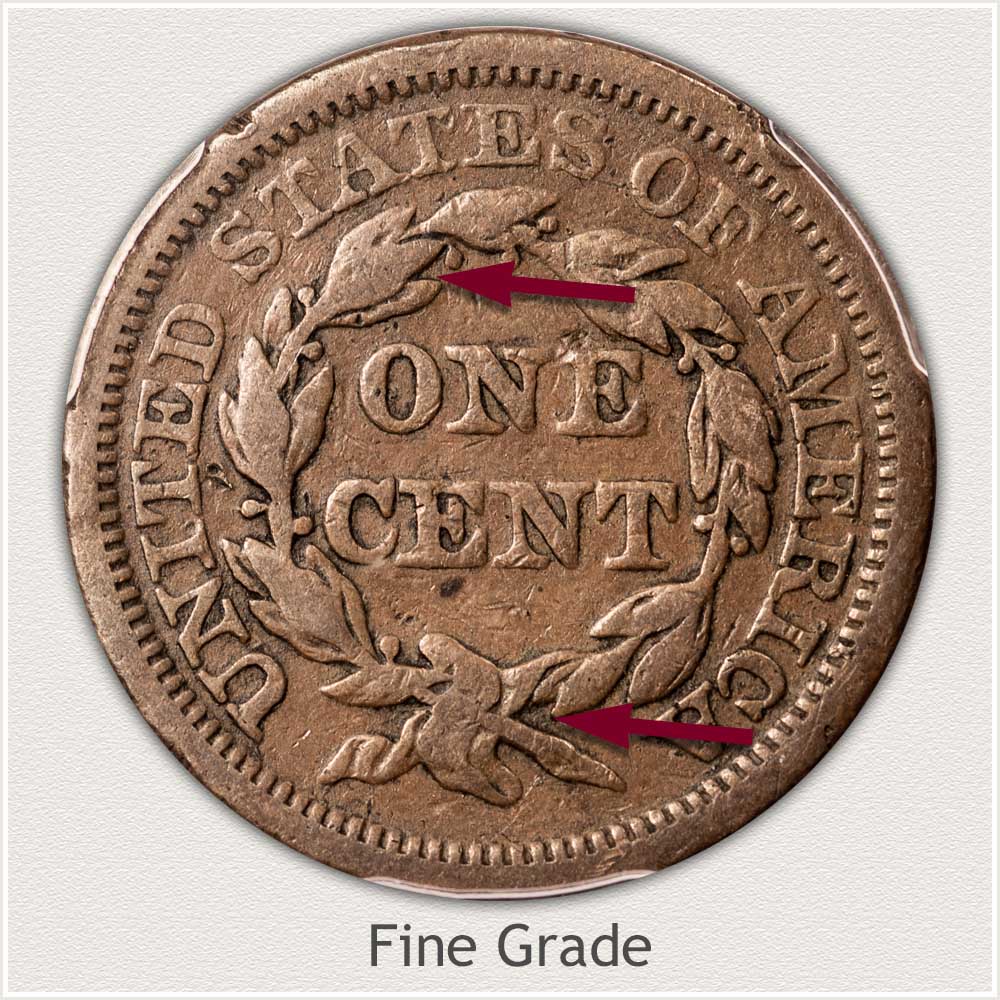
Reverse: Leaves of wreath remain boldly separated. Upper leaves are worn smooth with lower leaves showing flat areas.
Minor detail of raised edges within lower leaves indicates a Fine grade.
At the bottom, securing the ends of the laurel branch a recognizable ribbon remains. All edges and loops of ribbon show. Wear is concentrated on three main areas of the ribbon part passing over the stem.
Good Grade: Braided Hair Large Cent
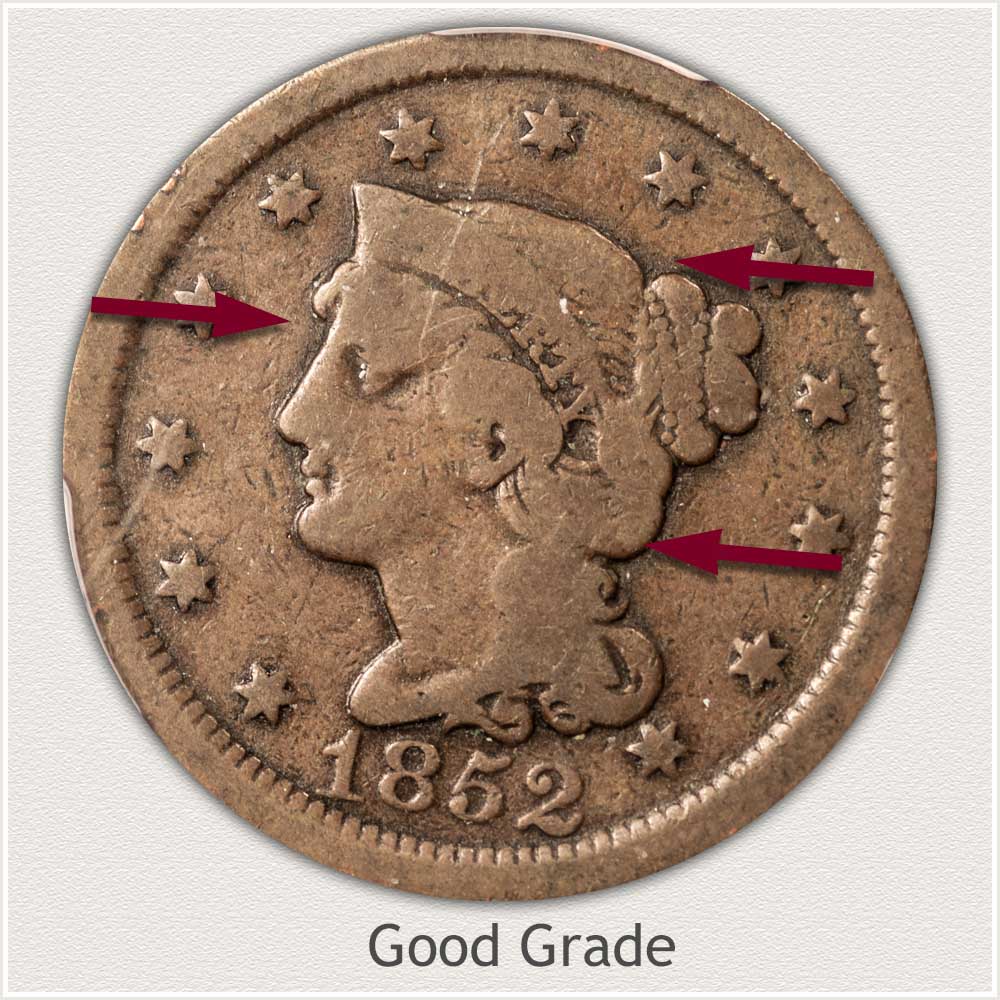
Obverse: Heavy wear and connected areas of flatness defines the Good grade.
Facial features of Liberty are now merged with many areas of hair line. Above the eye, missing is most of the defining lines of braided hair. Liberty's eye is now surrounded by flat areas.
Curls and waves of hair at back of neck are flattened and blending with neck.
Across the top of Liberty's head is a flat area extending to the two hair ties. A few lines of hair detail are present close to the coronet.
In the central area, a few letters of "Liberty" and some beads to the cords often remain, helping with a pleasing appearance to an otherwise heavily worn coin.
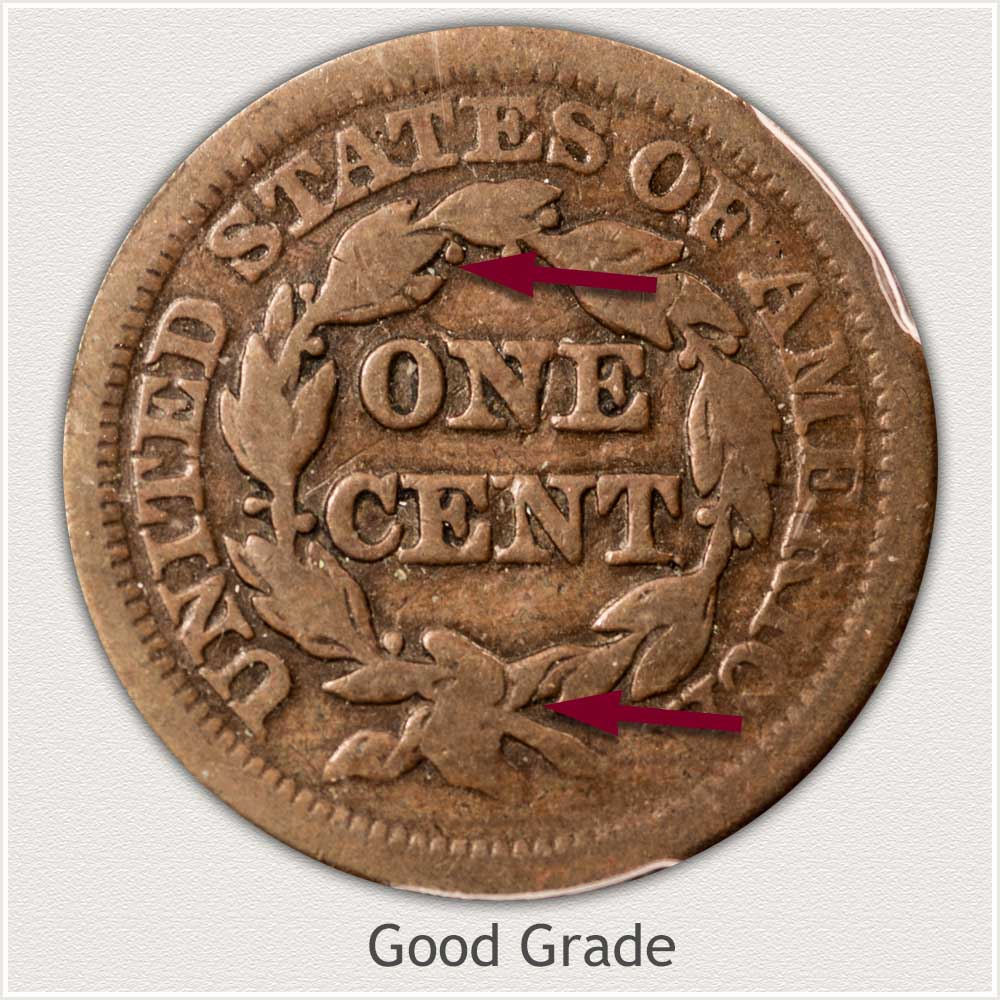
Reverse: Often the reverse fairs well despite heavy use, presenting a recognizable wreath.
Many of the leaves are separated although worn smooth, with the wreath still bold from the field.
The ribbon tying the wreath at the bottom lacks most minor and major edges. Ends of the ribbon are just beginning to fade into the field of the coin. Note: Boldly struck reverses often show a bolder ribbon.
Step 3: | Special Qualities Enhancing Value
One feature that can set your coin apart from others is the quality of its surfaces. Mark free surfaces are valued higher, no matter the grade of the coin. Corrosion also tends to spoil the appeal of the surfaces. Large cents are copper, large, and a soft metal. Surfaces show quickly any damage and poor storage conditions.
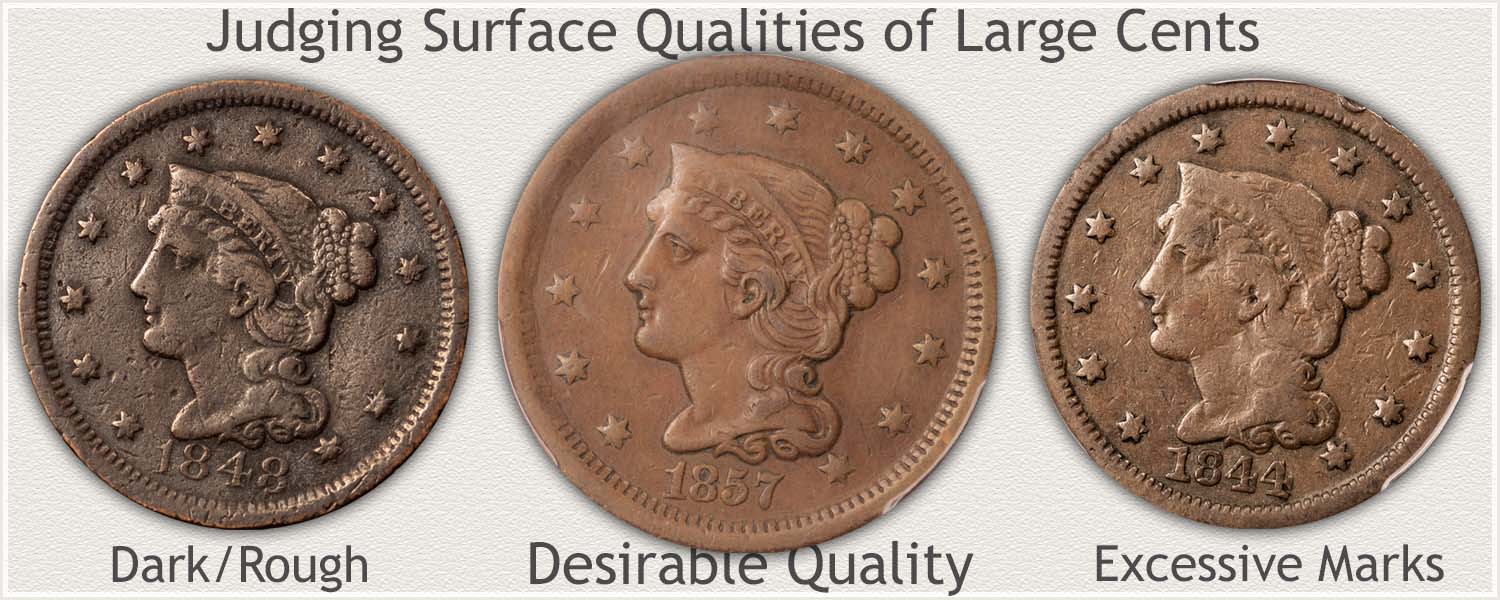
Of the three coins pictured, the center large cent is a clear favorite with collectors. Smooth surfaces and nice color raise the appeal of the 1857 large cent. The 1848 on the left suffers from multiple nicks and pitting due to corrosion of the metal. Eye appeal of the 1844 cent on the right is disrupted by the many scattered marks.
Corrosion
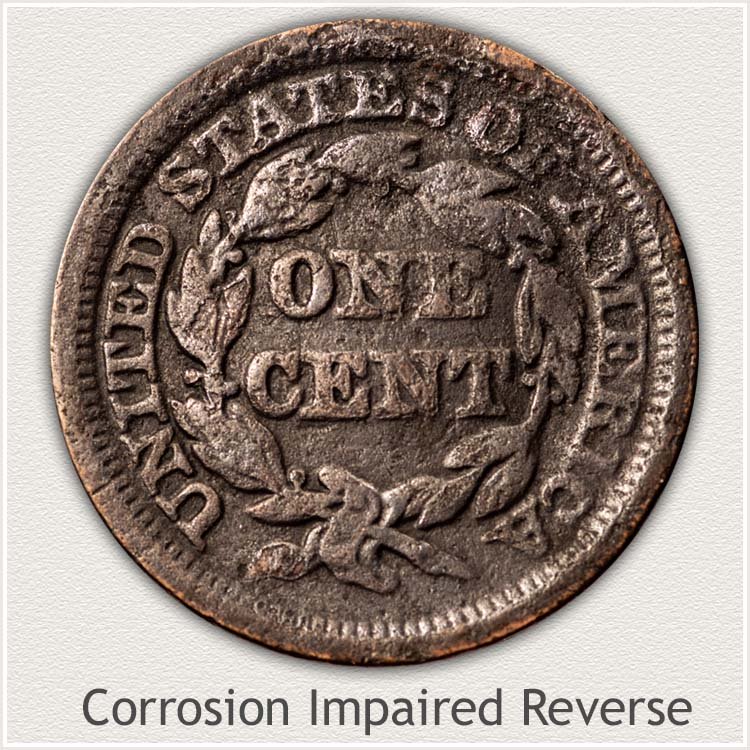
Corrosion is evidence of long-time storage in humid to wet conditions. Also, coins found in the soil corrode, leaving the surface pitted as evidence.
Damage
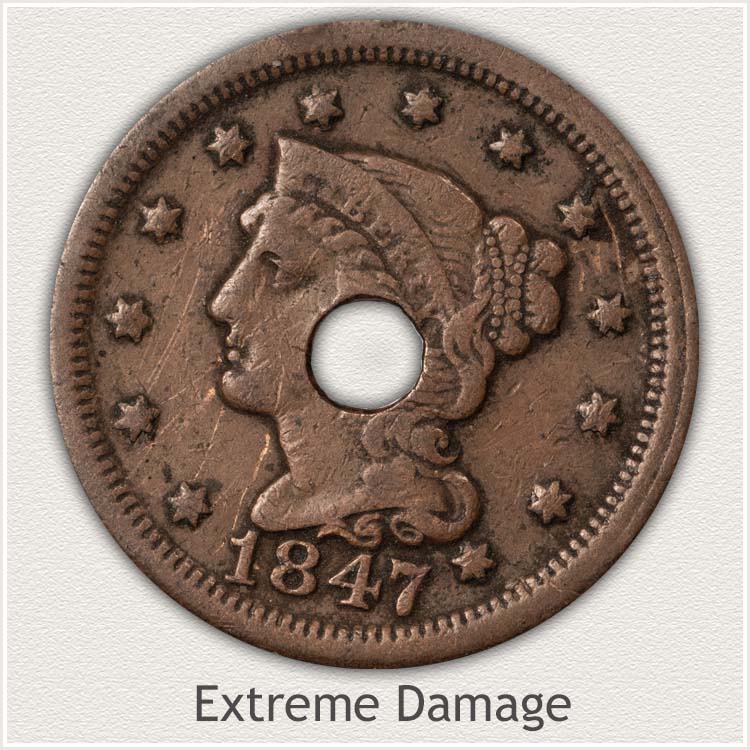
Once a hole is made in a coin, value is lowered considerably. Collectors consider damage caused by holes as severe, destroying any appeal a coin has as a collectible. The 1847 cent pictured is nice, would grade Fine plus. With the hole, value is just a couple of dollars.
When judging your coins, any positives or distractions are considered as part of the value process.
Grading a coin is not an exact science. It is your opinion, dealers and collectors have their own opinions... and they can all differ slightly. There is hope...
Collectors and dealers consider PCGS and NGC as leaders in coin grading services. They both authenticate, grade your coin, and identify any special varieties. Especially important with the earlier years where large cent values are often above $100. The small fee you pay provides assurance you understand and receive the full value of your coin.
References
US Mint. 1938 US Mint Annual Report.
https://nnp.wustl.edu/library/book/514142
US Mint. Catalogue of Coins of the United States.
https://nnp.wustl.edu/library/book/554591
Coin Values | CoinStudy Articles
Popularity helps support values of these old copper coins. Historical significance plus collectors forming collections keeps these coins steady to rising in how much they are worth. It is hard to imagine a lack of interest with such a diverse variety of large cents to collect.
It was through the efforts of George Washington and Thomas Jefferson the fledgling U.S. mint began to produce large cents for the American economy. The historical significance of this, all but guarantees the future popularity of the series.
An excellent picture index of all major US coin series. Compare and identify your coin to the picture, click on the image, and go immediately to your old coin value.
Discover your old penny values. From the rare Half Cents and Large Cents, to the popular Indian and Wheat pennies. Match your coins to the grading images and value charts. The current prices are worth exploring.
Coin Value Guide | How to Value a Coin Collection
A step by step method combined with the coin value online guide identifies how to value a coin collection. Discover how much your box of old coins is worth.
Selling Coins describes the different types of markets, and the type of coins to match each market. Extra effort for sure, but finding the best coin buyers yields the best results.
Old US Penny Values are Rising
Coin values are determined by using the grading images to judge condition then checking the date and values on the charts provided. Discover all the rare varieties, dates and mintmarks.
★Coin Values Discovery... find American Large Cent values and...
All old US coin values. It is an excellent index, quickly leading to the major coin series. From Cents to Gold. Get the best price if selling and finding coin buyers by knowing accurate values.
Having a good understanding of the value of your large cents is especially important when deciding on selling coins. You are now in a better position to finding the right coin buyers.
